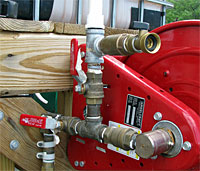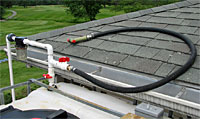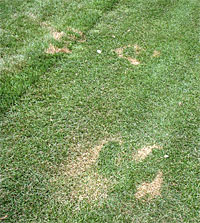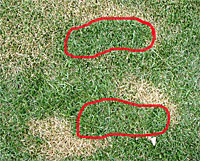What Happens When It's 100 Degrees?
Paul Sabino, The Farms Country Club, Wallingford, CT:
 "We water everything we can over and over and over! There are several things we do to help the turfgrass survive the intense stress. Mostly, light frequent watering helps get the turf through the hottest time of the day. We constantly scout for isolated dry spots by using soil probes. The soil probe takes a small diameter core from an area and the trained staff diagnoses the amount of water needed for the application. Using too much water can be just as bad as not enough. Night watering mostly provides moisture to the soil profile. Daytime watering is used to cool the turf down and remedy the isolated dry spots. Hand watering with hoses is the most efficient and beneficial way to combat heat stress. The water goes exactly where we want it. "We water everything we can over and over and over! There are several things we do to help the turfgrass survive the intense stress. Mostly, light frequent watering helps get the turf through the hottest time of the day. We constantly scout for isolated dry spots by using soil probes. The soil probe takes a small diameter core from an area and the trained staff diagnoses the amount of water needed for the application. Using too much water can be just as bad as not enough. Night watering mostly provides moisture to the soil profile. Daytime watering is used to cool the turf down and remedy the isolated dry spots. Hand watering with hoses is the most efficient and beneficial way to combat heat stress. The water goes exactly where we want it.
When temperatures reach the extreme, like today, we may have as many as seven people working on irrigation. Today there are two men on patrol. They scout the course and direct four men with hoses. The seventh man is driving a 160 gallon water tank and takes care of the landscape plantings.
In addition to the labor force, we use several different wetting agents to help get the water into the soil. Wetting agents are applied several different ways. Direct injection into the irrigation system, pellets used inside proportioners on the one inch hoses and/or spray applications. In essence, wetting agents break the surface tension and allow the water to penetrate. They make water "wetter".
Visit Paul's blog at http://farmsccsuperintendent.blogspot.com
|
 |
Sprayer Pre-Mix Tank
Justin Parker, Equipment Tech, Stow Acres Country Club, Stow, MA:
 "One of the most important cultural practices here at Stow Acres Country Club is spraying our greens, tees and fairways. On average, we spray twice each week. We have two dedicated sprayers, one 175 gallon Spraytek DS175 for greens and tees, and a 300 gallon Toro Multipro 5700 for fairways. Given the volume of the tanks, and the precision with which the sprays are mixed, it can take upwards of an hour to fully load the sprayer. Each spray is typically 2-3 loads, which requires 2-3 hours or more of mixing and loading the spray. This season, we decided to change the process up a little. "One of the most important cultural practices here at Stow Acres Country Club is spraying our greens, tees and fairways. On average, we spray twice each week. We have two dedicated sprayers, one 175 gallon Spraytek DS175 for greens and tees, and a 300 gallon Toro Multipro 5700 for fairways. Given the volume of the tanks, and the precision with which the sprays are mixed, it can take upwards of an hour to fully load the sprayer. Each spray is typically 2-3 loads, which requires 2-3 hours or more of mixing and loading the spray. This season, we decided to change the process up a little.
We built a Pre-Mix Tank to facilitate mixing the spray while the spray technician is in the field treating the turf. The first step in the process was selecting a tank. We used a 275 gallon bulk fertilizer tank. 275 gallons of water, at 8.35 lbs per gallon, weighs 2300 lbs. With this in mind, we built a pressure treated stand of the same design as a hot tub deck. The stand also includes an area to stand on while loading the mix.
The tank was then modified to fit our design. We cut in a bulkhead with straining screen. The mix tank is powered by a 3/4 hp sump pump that drives a sprayer fill valve, in line strainer screen with bypass, and agitation nozzles to keep the products adequately mixed prior to loading. The tank is filled from our 120 psi South Course irrigation. An inline strainer screen filters the water before entering the tank. A custom aluminum fill hose frame was built and hinged to the tank. To facilitate the arm swinging without binding the fill hoses, we installed swing joints at both pivot points (upper and lower fill hoses). A platform was mounted to the tank cage with a cutout for the calibrated mixing cup.
Once we started using the mix tank, the time spent by the spray technician at the shop between loads has decreased from an hour or more, to only 5 minutes.


|
UPDATE: After using the mix tank for a couple weeks, we added a few new features to make it more usable. To facilitate faster filling, we plumbed the irrigation water from the South Course directly into the tank. Filling the entire 275 gallon tank with the irrigation line takes under 5 minutes. To help screen out any of the debris that makes it through the irrigation lines, we installed a fine mesh strainer screen. There’s also a quick disconnect in line, in case we ever have to move the tank for some reason. In the event that the irrigation is not pressurized, a 3/4″ female hose thread swivel connector was installed to allow the hose from the well water to be hooked up to the fill line.
For ease of rinsing containers and the mix tank itself, we also installed a 6′ hose with quick connect and a nozzle to the fill line. Valves allow one or both to be operated at the same time.
Visit the Stow Acres blog at http://stowacresturf.com and Justin's personal blog at http://golfcoursetech.wordpress.com.
|
 |
A cool look at a greens mower...
Chris Tritabaugh, Northland Country Club, Duluth, MN:
 "My guess is most golfers have, at some time, stood and watched a member of the turfgrass staff walk-mow a green. It's almost as mesmerizing as watch a Zamboni, trouble is it happens way too early in the morning for people to see. While we have all watched these machines moving over the putting surface leaving behind a beautiful cut, it's unlikely most have given any thought to just exactly how these mowers cut the grass so low and so perfectly. Friday I was out on the 18th green adjusting the out-front brush on one of our walk mowers. I got down on my hands and knees to look at something and realized that I had a very cool photo staring me in the face. "My guess is most golfers have, at some time, stood and watched a member of the turfgrass staff walk-mow a green. It's almost as mesmerizing as watch a Zamboni, trouble is it happens way too early in the morning for people to see. While we have all watched these machines moving over the putting surface leaving behind a beautiful cut, it's unlikely most have given any thought to just exactly how these mowers cut the grass so low and so perfectly. Friday I was out on the 18th green adjusting the out-front brush on one of our walk mowers. I got down on my hands and knees to look at something and realized that I had a very cool photo staring me in the face.

There are a number of things to see in this photo.
The smooth front roller. You can also see the back roller of the cutting unit on the very left of the photo. Our walk-mowers, the Toro Flex-21, have three rollers; two on the cutting unit and the rear drum, which drives the unit across the green. We use only smooth rollers on all of our reel mowers. The smooth surface drastically reduces surface disruption and plant stress.
Between the two rollers you can see the business areas of the cutting unit; the reel and bedknife. Unlike the rotary mowers you use on your lawn, which spin a sharp blade at a very high rate, reel mowers cut the grass blades like a scissors. The bedknife (the very end of which is visible) is stationary and forms one blade of the "scissors" as it moves just over the surface of the green. The spinning blade of the reel forms the other blade of the "scissors". The reel on this mower has 11 blades and spins to continually clips the blades as the mower move across the green. The relationship between the reel and the bedknife is everything when it comes to producing a quality cut. Our mowers are set up such that the reel and bedknife are not quite touching each other. The gap between the two is about the thickness of a piece of paper. After each mowing the reel to bedknife set-up is checked, as well as the height of cut. A poorly set up mower results in the grass blades not being cut cleanly, which can result in: poor putting conditions, increased need for fertility and water, as well as an increase likelyhood of disease. The spinning of the reel throws the clipping into an attached basket where they are collected. When conditions are just right a single mower will collect a half basket or less of clippings per green.
As you can see in this photo, the mowing of a putting surface happens on a very small scale. The cutting height on greens is currently .115 inches, just above 1/10 of an inch. At these heights any problems with the reel to bedknife set-up can cause big issues with the quality of the putting surfaces. Next time you watch that mower cutting a perfect line across a green you will have a little better idea of just how it works.
Visit Chris's blog at http://northlandgrounds.blogspot.com
|
 |
Turf Twister
John Temme, The Wakonda Club, Des Moines, IA:

The damage is pictured above. The turf is Kentucky Bluegrass and is located in the primary cut of rough on hole #10.

The area outlined in red shows a distinct pattern.
|
 "We found some unique turf damage on the golf course today. See if you can figure out the cause... These areas appeared after our July 4th celebrations at the club. There were activities for children and many families walked to other locations on the property to get a good view of the fireworks. The cause of this damage is... Insect Repellent! The pattern shows a well-intentioned mother or father lined their children up like ducks in a row and gave them all a treatment, undoubtedly to prevent itchy mosquito bites. We see insect repellent damage every year and the damage can be confusing at first but once you spot the flip-flop prints the diagnosis is a lock. "We found some unique turf damage on the golf course today. See if you can figure out the cause... These areas appeared after our July 4th celebrations at the club. There were activities for children and many families walked to other locations on the property to get a good view of the fireworks. The cause of this damage is... Insect Repellent! The pattern shows a well-intentioned mother or father lined their children up like ducks in a row and gave them all a treatment, undoubtedly to prevent itchy mosquito bites. We see insect repellent damage every year and the damage can be confusing at first but once you spot the flip-flop prints the diagnosis is a lock.
Luckily this damage occurred in the rough and this turf will recover. However, we would like to promote the application of these products in the rough only and not on the green, tee, or fairway - ideally on the cart path!
Visit John's blog at http://wakondagrounds.blogspot.com
|
 |
These guys are STYLIN'!
We offered to help you put your best foot forward by customizing a blog theme or email header for you, and these guys have taken advantage so far:
 Custom blog header
 Custom blog header and theme
 Custom blog header and theme

Custom email header
The offer is still open, so send us some course photos (at least 1000 pixels wide), a headshot or two of yourself and a club logo... and we'll take it from there! No charge, of course, for TurfNet members only. Yet another advantage of being a TurfNet member!
|
 |
|
About our Blog Aggregator: Many superintendents are now hosting private blogs to better communicate with their golfers and/or members. Beyond local weather and course conditions, there is a great deal of information about projects, methodologies and techniques that would be of value to other superintendents — hence our Turf Blog Aggregator. As every blogger struggles occasionally with content, we will also include posts intended to educate golfers about turf maintenance for others to use as a template for their own blogs.
TurfNet members: Want to share something from your blog? Send us the link.
Turf Blog Aggregator(TM) is a trademark of Turnstile Media Group.
|
|